HMS Forward (1904)
 | |
| History | |
|---|---|
| Class and type: | Forward-class scout cruiser |
| Name: | HMS Forward |
| Builder: | Fairfield Shipbuilding and Engineering Company, Govan |
| Laid down: | October 1903 |
| Launched: | 27 August 1904 |
| Commissioned: | September 1905 |
| Fate: | Sold 27 July 1921 for scrapping |
| General characteristics | |
| Displacement: | 2,860 tons |
| Length: | 365 ft (111 m) (p/p), 379 ft (116 m) (o/a) |
| Beam: | 39 ft 3 in (11.96 m) |
| Draught: | 14 ft 3 in (4.34 m) |
| Propulsion: |
|
| Speed: | 25 knots (46 km/h) |
| Range: | Carried 150 tons coal (500 tons max) |
| Complement: | 298 |
| Armament: |
|
| Armour: |
|
HMS Forward was one of two Forward-class scout cruisers which served with the Royal Navy. She was built in the yards of Fairfield Shipbuilding and Engineering Company, Govan. She was laid down in October 1903, launched on 27 August 1904 and completed in September 1905. She was initially given a main armament of ten 12 pounder guns but in 1911/12 these were replaced with nine more potent 4 inch guns.
Career
HMS Forward joined the Channel Fleet in 1907, became leader of the 2nd Destroyer Flotilla in 1909, joined the 4th Flotilla in October 1909, the 3rd Flotilla at the Nore Command in 1910, becoming its leader in June 1913. At the start of the war she was part of the 9th Destroyer Flotilla, on the Shetland Patrol.
In 1914 she was transferred to the 7th Destroyer Flotilla on the Humber. On 15 December 1914 she was at Hartlepool, along with HMS Patrol and the 3rd division of the 9th Flotilla, while the 4th division was patrolling off Whitby. On the morning of 16 December Hartlepool was the subject of a German raid, led by the battlecruisers Seydlitz and Moltke and the cruiser Blücher. Hartlepool was a tidal harbour, and at low tide it was difficult for the cruisers to get out to sea. That morning the destroyers HMS Doon, HMS Waveney, HMS Moy and HMS Test had been sent out at 5:30 am, and had reported that the conditions made it risky for the cruisers to come out.
At 8 am, the German ships appeared off Hartlepool and opened fire on the town. Their initial targets were the two gun emplacements that protected the harbour, but they soon opened fire on the docks and harbour entrance. While Patrol was able to get out to sea (where she was hit and badly damaged), Forward was delayed by the German barrage. When she did finally get out of Hartlepool, the German battlecruisers had already turned east to make their escape. Forward was ordered to keep in touch with them, but they soon escaped into the mist.
After the raid Forward was sent to the 7th Destroyer Flotilla in the Humber. In May 1915 she was one of five of the seven surviving scout cruisers to make up the 6th Light Cruiser Squadron, whose duties were to guard the east coast against Zeppelin raids. This squadron was soon broken up as newer ships became available, and Forward was sent to the Mediterranean. From June 1916 to the end of the war she served in the Aegean. Early in 1919, under the command of Arthur Bedford, Forward rescued members of the Tolstoy family from the evacuation of Odessa, about to be captured by the Bolsheviks.[1] She was finally sold off on 27 July 1921.
References
- ↑ Lionel Dawson, Mediterranean Medley (Rich & Cowan, 1933), pp. 26-27
- Colledge, J. J.; Warlow, Ben (2006) [1969]. Ships of the Royal Navy: The Complete Record of all Fighting Ships of the Royal Navy (Rev. ed.). London: Chatham Publishing. ISBN 978-1-86176-281-8. OCLC 67375475.
- Jane's Fighting Ships of World War One (1919), Jane's Publishing Company
- Forward class in World War I
- History of the Forward class